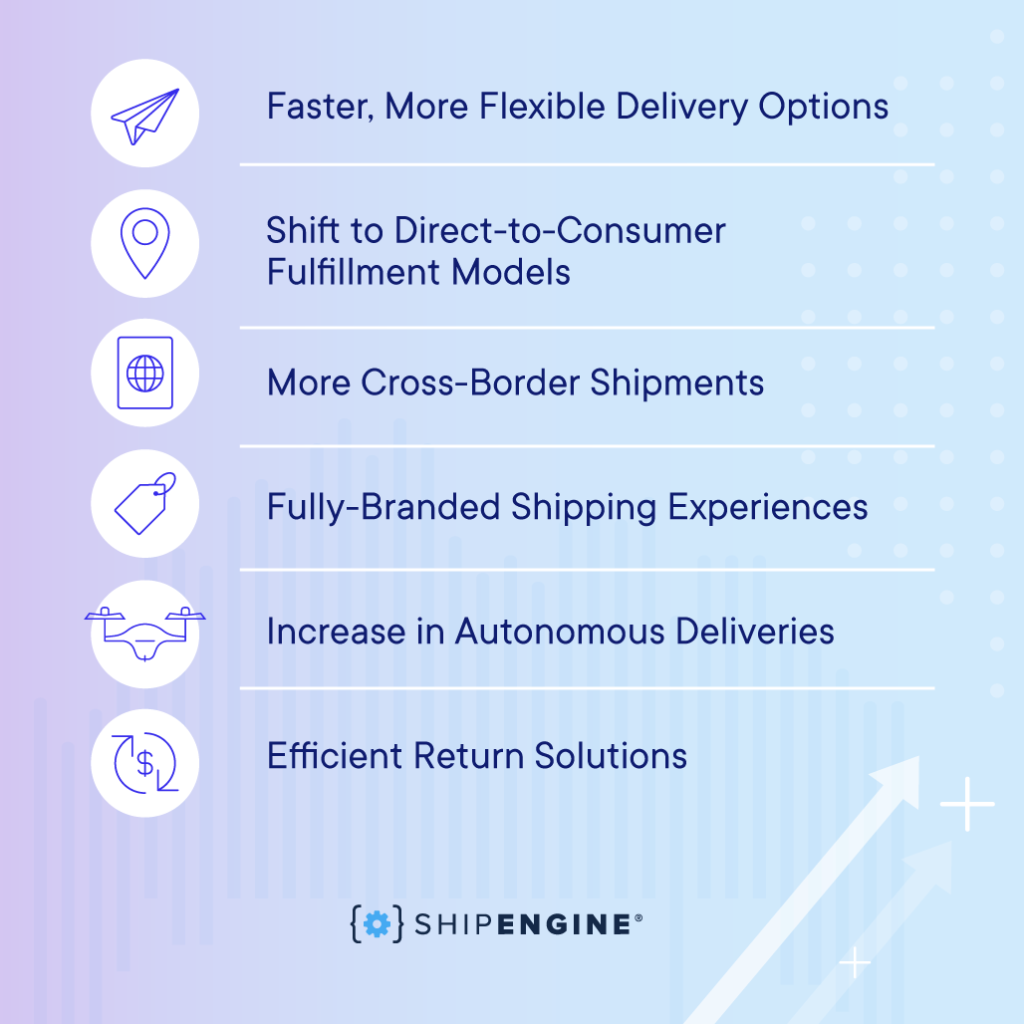
The world of e-commerce is always evolving, largely based on consumer demand, technological advancements, cost, and efficiency. With these changes come direct consequences on the ways we ship. There’s a big piece to be had of the current $3.46 trillion global e-commerce market, so — particularly around this time of year — it’s important as a brand to stay vigilant in the way you research, plan, and set goals.
We’ve done a little research and goal setting of our own, and we put together our predictions for 2020 trends that will change the landscape of shipping logistics, from e-commerce brands to warehouse management.
1. Faster, More Flexible Delivery Options
If you ask consumers, many will say that the delivery experience can make or break their relationship with a brand. And, now more than ever, customers have been conditioned to expect fast and customizable delivery options. According to one report this year, consumers cite these three reasons for cart abandonment:
- Lack of Delivery Options
- Shipping Costs
- Long Shipping Times
Whether you’re a small or enterprise business, you are competing against marketplaces with the capacity to provide 1- and 2-day shipping — and, traditionally, this is an expensive fulfillment model. Last-mile delivery has emerged as a popular option for some, allowing sellers to warehouse product closer to the final destination. This not only helps curb costs, but it also provides quicker delivery.
This year, we’ve also seen the introduction of flexible delivery options where customers can choose monetary rewards for their willingness to wait a little longer for a package. We anticipate that more e-commerce brands will mirror this by offering in-store credit or discounted shipping when buyers opt for a slower delivery service.
2. Shift to Direct-to-Consumer Fulfillment Models
Direct-to-Consumer Fulfillment gives brands complete control over their products and reputations. A great example of this model is Amazon’s Seller Fulfilled Prime. This removes Amazon from the fulfillment process completely and allows the merchant to ship directly to the consumer. This cuts down on costs and fees associated with warehousing and needing to hire a third-party logistics provider.
3. More Cross-Border Shipments
We now live in a world where borders and oceans matter less than they used to, but it can still be an intimidating step for businesses to take. However, there are businesses and programs that can make global shipping easier to achieve and cheaper to execute — like offering services such as global currency accounts, low-cost currency exchange rates, and simplifying the VAT reporting process.
4. Fully-Branded Shipping Experiences
There’s no question that creating a branded experience for your customers helps foster loyalty. As time has passed, sellers have found various ways to extend their brands via non-traditional components in impressionable ways. Take for instance the signature smile printed on the side of every order fulfilled by Amazon; it’s become a recognizable way for consumers to know who shipped the package that just arrived.
In 2020, we predict more opportunities for small- and medium-size businesses to compete with these big-brand experiences, through customizable tracking pages, the ability to print logos on carrier-approved shipping labels, and more.
5. Increase in Autonomous Deliveries
Automation is the way of the future. There are so many different ways in which this affects the shipping industry, but one of the ones we’re most excited about is autonomous delivery. While many think of self-driving trucks, this also includes drone deliveries, which UPS (among other carriers) has announced as a 2020 goal after achieving its FAA-certification.
These autonomous delivery solutions will provide carriers and last-mile logistics providers with more efficiency when it comes to delivery routes. They will also provide the opportunity for additional real-time data that can help brands and carriers optimize their businesses.
6. Efficient Return Solutions
One of the ways brick-and-mortars still beat out e-commerce sellers is through their ability to accommodate simple (and FREE) returns. More and more online brands are embracing try-on-at-home features and pre-paid return programs in order to compete with the in-store experience.
However, shipping labels are costly. And no one wants to pay for things that don’t get used. In 2019, we’ve seen a surge in pay-on-use return labels, or scan-based returns. These provide a convenient return solution for customers without requiring merchants to pay for shipping labels that don’t get used. Our prediction for next year is that we will see an increase in how many brands utilize these to help maximize efficiency with online returns.

At ShipEngine, we’re always aiming to stay ahead of the shipping trends curve so that we can provide our users with the most efficient and effective full-featured shipping API. If you have any questions on how we can help your business achieve simplicity in your logistics and fulfillment workflow, feel free to reach out to our sales team.
Want to test out ShipEngine as your shipping API solution? Get a free API key now.


Leave a Reply